Chopping Mall
Chopping Mall was my first blog, which I started way back in 2009. It was dedicated exlcusively to ridiculous and terrible films, which I watched a lot of back then. (So much time, so little work!)
I’ve resuced the posts from oblivion, to be preserved here for …uh… whatever.
It’s a pretty clunky process getting them out of blogspot (XML export, eww) and into here, so there may be a few formatting issues.
What Have You Done To Solange? / Cosa avete fatto a Solange?
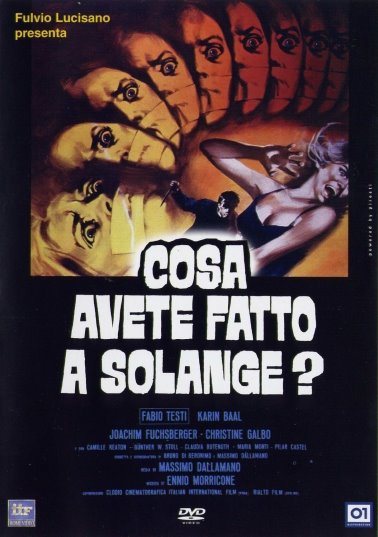
The Italian Giallo films are perhaps not best known for being the most sophisticated cinematic creations of all time. Characterised by murder, mystery and sex, they equate more or less with our idea of a thriller, pulp-fiction Euro-cine. But with more sex.
It came as a surprise then just how good What Have You Done To Solange? was. On paper, admittedly, it looks as smutty, crass and trashy as you could expect from a Giallo (or any low-budget offering from the trash-flick capital of Europe): it’s set in a Catholic girls school full of illicitly promiscuous teens, a teacher (the Italian professor, no less) is courting his pupils behind his wife’s back, girls are getting killed with knife-wounds in unpleasant places and an unknown girl -the Solange of the title- is the link…

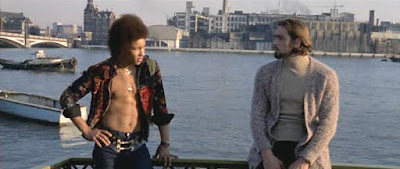
But that’s where I have to stop giving away the details. Because, as much as it may come as a surprise, What Have You Done To Solange? is actually a pretty good film. The mystery is surprising, the story is tense, well-paced, interesting. You actually WANT to know what’s going on.
Sure, the girls only seem to have conversations whilst taking communal showers, sex is entirely central to the plot: this is certainly no genre-defying masterpiece, but is entertaining and worth watching as a film. And not just softcore Italian trash…
An extra piece of trivia: the film is almost unnoticeably dubbed; the creators had intentions on the English-speaking markets, where dubbed films do poorly, and made everyone speak their lines in English, their strong accents were dubbed over, but their lip movements match the English.
As if all of that wasn’t enough to convince you, the film is soundtracked by the inimitable Mr Morricone…
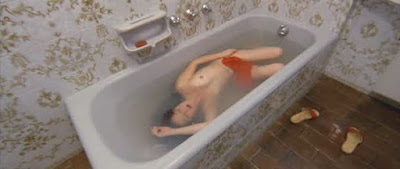
Cemetery Without Crosses (Une Corde, Un Colt)

Westerns are in an odd place these days. The culture of the Western is so deeply ingrained in our collective consciousness that everyone is familiar with some, if not all, of the classic clichés and norms of the Western film. Goodies wear white hats, baddies wear black. They smoke. They shoot. They drink whisky. They fight in bars. They barge through saloon doors, chase each other on horses across the desert, dash over the border to Mexico when the heat’s on, have quick-draw shoot-outs at high noon, etc, etc.
Part of the reason for this collective knowledge is that Western films were simply MASSIVE once uipon a time. A well-established genre on both sides of the Atlantic, Western films were big business whilst (for the European Spaghetti Westerns at least) being dirt cheap to produce.
So why, years later do we remember the clichés but forget the films? Why do we remember only Clint Eastwood as THE Western star, Segio Leone as THE director and Ennio Morricone as THE composer?
THe simple, obvious and so most likely true (thanks Occam’s razor…) answer to these questions is that, despite the enormous number of Wesrern films they were mostly pretty damn similar, forcing us to rememember the key clichés but being otherwise mostly forgettable. Eastwood, Leone and Morricone just happened to be the best…
Of course, this doesn’t mean we should forget the rest. There are some excellent Westerns available and Cemetery Without Crosses is one of the best. And guess what? Neither Eastwood nor Morricone are anywhere to be seen!

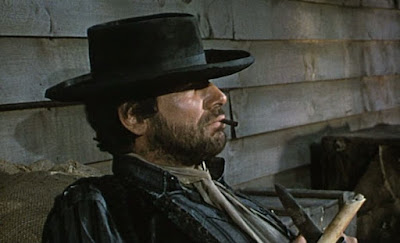
Leone however, does stamp his presence here; the film is very much a tribute to his style (which is no bad thing!) and he even guest directed what is possibly the best and most tense scene of the movie, the meal at the Rogers family ranch.
THe story, then, is interesting and tense, albeit very predictably Spaghetti-Western-y. Despite Manuel’s (Robert Hossein) rebuttal of “You believe in revenge. I don’t. It never ends”, this is a story of revenge and, equally predictably, it all ends in tears.
The Rogers have killed one of the Caines and, though the brother Caines are preparing to flee with their cash, the freshly-widowed Mrs.Caine is spitting blood and demmands revenge. Cue involvement of old flame Manuel and a whole lot of people getting shot.
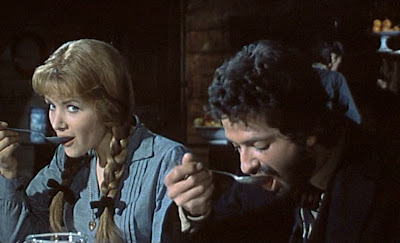
Sexual tension in the Leone-directed dining scene…
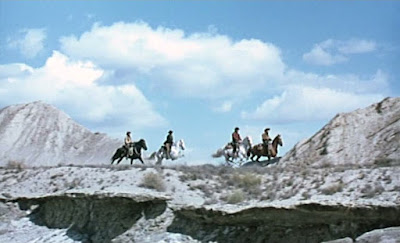
So no great innovation in terms of plot, but sometimes its executgion rather than originality that’s important. What is noticeable is an unusually positive role for women. Western’s female characters tended to be demure and pathetic or prostitutes; here we are thankfully given some strong women who manage to assert themselves. Even without taking off their clothes! Something of a rarity for cheap films of the era…
Cemetery Without Crosses is beautifully shot - full of lots of long static camera angles - and keeps tension high throughout, with sparse dialogue and long silences that threaten to bore at times but mostly thrill. The soundtrack doesn’t suffer either, director and star Rob Hossein’s father André providing some suitably stompy, whistle-y tunes that fit the picture perfectly.
In all, Cemetery Without Crosses is an exciting, well-written and well-directed Spagheti Western that, although probably somewhat forgettable, is `definitely an entertaining watch.
As an extra aside, it is worth noting the writing credit given to a certain b-movie legend, Mr Dario Argento. Argento was fresh from a taste of success in writing for Sergio Leone’s (him again) Once Upon A Tine in the West and obviously saw another Western as a sensible move. Director Rob Hossein has since claimed however that Argento played no role in the cresation of the film, suggesting that his onvolvement might not have gone as smoothly as hoped…
Poster Hunt #1 - Last orgy of the Gestapo...
Poster Hunt #1 brings you a fantastically tasteless mix of sex and Nazis. Strangely unlisted on IMDb, here is… La Última Orgia de la Gestapo!
On IMDb here, albeit with a slightly different title. The reviews aren’t great…
Dead End Drive In
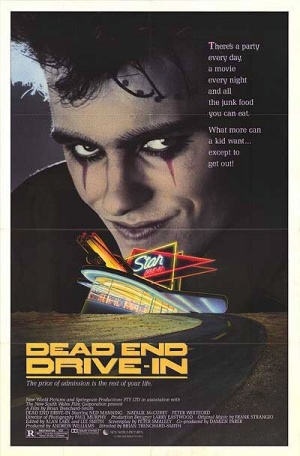
I’ve had this film hanging around for ages now and just hadn’t quite got round to watching it. In that time, I’d forgotten what little I knew about it and, in my head, it had become just some run of the mill slasher set in a drive-in cinema. I was wrong.

This is an Australian film from the 80s (and it really is very 80s…) that play on/cashes in on the popularity of Mad Max. Taking a similar kind of post-apocalyptic society as it’s base, this plays as a kind of Mad Max flavoured meeting of Escape from NY and The Cars That Ate Paris (If you haven’t seen either of those, go and do so. Now).
The premise is fairly simple. America’s collapsed, the world’s in trouble, there’re no jobs in Australia, thugs (‘cowboys’) in modified cars terrorise the streets by night, the police deal brutally with anyone they catch. So far, so good.
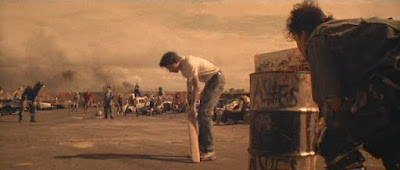
Playing cricket in the Cinema-prison
A news report, right at the start, makes a big deal of the government’s success in reducing unemployment. We think nothing of it, until shortly later when we discover how this is being achieved; the police are locking all the unemployed into out-of-town drive-in cinemas. And keeping them there.
The odd thing is that most of the unemployed really don’t mind. Once imprisoned, they are fed, they needn’t work, they can watch films. In many ways they live a very free life… inside the electrified fences of their cinema-prison. Not so for ‘Crabs’ however; besides sporting one of the worst nicknames in cinema history, Crabs is keen to escape and this film is his story. And it’s a fun story; there’s sex, there’s fighting, there’s car chases, there’s even a pretty good 80s soundtrack. Whilst you could never claim this to be an intellectual heavyweight of a film (although there are some not-so-subtle observations of racism in Australian society), it’s certainly a lot of fun.
Decidedly implausible, really quite silly, heaps of fun. Strongly recommended.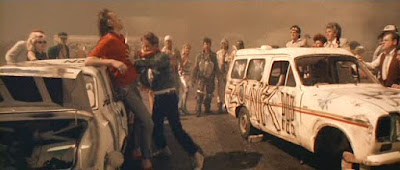
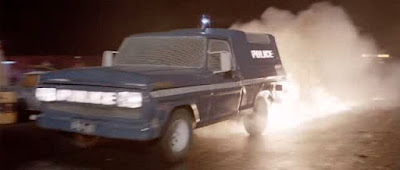
They Came Back (Les Revenants)
Yes, this is technically a zombie movie. Yes, this involves the recently deceased emerging from their graves and returning to life. Yes, it is French.
Here, though, the comparisons to Jean Rollin’s godawful Zombie Lake end. Because Les Revenants isn’t your standard zombie movie, it isn’t really a horror film at all. It is however, very, very French.
In much the same way that the recent (and wonderful) Let The Right One In manages to be a vampire film without really being about the routine vampire-mythology horror clichés, Les Revenants takes a very different approach to the zombie film.
We’ll start with the zombies themselves: what most films seem to overlook when bringing the recently deceased back to life is that, by and large, the recently deceased are likely to be, well, a bit old. So here, instead of having legions of youths dragging themselves out of their graves, we have a horde of the grey undead, 65% of whom are over 60…

Secondly, the fairly major distinction between this and pretty much all other zombie films is that the freshly reanimated have no lust for blood or brains whatsoever. They simply want to return to their lives. This has some pretty awkward results; most of their families have mourned them as dead and are at a bit of a loss as to how to suddenly factor all these people back into their lives. How do you interact with your (until recently) dead wife? They also pose a bit of a problem for the whole town, with 13,000 returning, the massive increase in numbers throwing the balance of the population. They’re housed in community centres, helped as if they were refugees arriving from war torn lands.
The film then, is about the relationships that are re-awakened by the return of the dead; we focus mainly on two husband-wife relationaships and a child returning to his bereaved parents. That’s not to say the film isn’t creepy. There may be no gore, no moments of shock and horror, but there are several distinctly unsettling moments of suspense. The child in particular is creepy as anything…
As well as this focus on how we deal with loss and personal tragedy, the film asks about what it is to be alive; we are told that those who return have incomplete personalities, that everything they say and do is just a re-hashed version of what they remember doing, that they are incapable of original thought. So are they alive? All they can do is follow a set of responses that are borne out of their memories but… isn’t that what we all are?
So farm so good. Now we move to it’s French-ness. The film is beautiful. The film is thought provoking. The film is full of suspense. The film is SLOW. So very little actually happens that it really does drag a bit.
The film is novel, unsettling and beautiful but ultimately flawed. Not creepy enough to scare you and not quite intense enough to justify one and three quarter hours of undivided attention. It’s definitely worth a watch and it will make you think, but I doubt it’ll change your world.
(Haven’t been able to find a trailer…)
